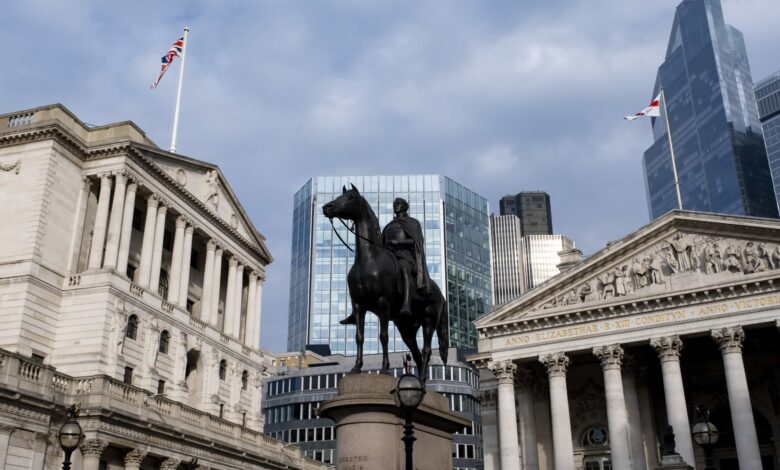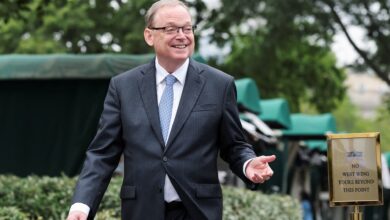Bank of England narrowly votes to cut interest rates to 4% as balancing act continues

Bank of England, the Royal Exchange and the statue of the Duke of Wellington in the City of London on 19th February 2025 in London, United Kingdom.
Mike Kemp | In Pictures | Getty Images
The Bank of England cut interest rates from 4.25% to 4% on Thursday as the central bank resumes a “gradual and careful” approach to lowering interest rates.
The BOE was widely expected to trim rates by 25 basis points at its latest monetary policy meeting, but traders and economists were keen to see the breakdown of support for the decision among the bank’s policymakers.
As it turned out on Thursday, the nine-member MPC voted by a majority of 5–4 to reduce the key interest rate, the “Bank Rate,” by 25 basis points rather than keeping it on hold. The British pound rose 0.5% against the dollar after the decision, to $1.3424.
Policy makers have had to weigh up sticky inflation — the consumer price index (CPI) rose to a hotter-than-expected 3.6% in June from 3.4% in May — with a cooling jobs market and lackluster growth. The U.K.’s gross domestic product contracted 0.1% month-on-month in May.
In a statement Thursday, the bank said the MPC “remains focused on squeezing out any existing or emerging persistent inflationary pressures, to return inflation sustainably to its 2% target in the medium term.”
The MPC was initially split on reducing or holding interest rates with four members wanting to hold rates, four others voting to cut and one policymaker voting for a larger 50-basis-point cut. The committee then held a second round of voting to arrive at a majority decision to cut rates by 25 basis points.
Despite the divergent views of policymakers at the BOE, economists expect the downward trajectory for interest rates to continue into next year, but the central bank reiterated its cautious approach, noting that “a gradual and careful approach to the further withdrawal of monetary policy restraint remains appropriate.”
The timing and pace of future reductions in the restrictiveness of policy will depend on the extent to which underlying disinflationary pressures continue to ease, the BOE said.
U.K. Chancellor Rachel Reeves said the central bank’s fifth interest rate cut since the last general election in July 2024 was “welcome news, helping bring down the cost of mortgages and loans for families and businesses.”
George Brown, senior economist at Schroders, said the latest rate cut was no surprise, but said “the path forward is anything but clear.”
“Jobs, growth and inflation figures all call for different policy prescriptions, as reflected in the unprecedented two rounds of voting needed to reach a majority,” he said in emailed comments.
“Given the uncertainty presented by the conflicting data, the committee is right to stick to its ‘gradual and careful’ mantra. “Nervousness about the labour market might prompt another cut in November. But this will be difficult to justify unless disinflation is clearly underway. As such, we think there is a decent chance rates will not fall below the current rate of 4% this year.”
Ahead of the rate decision, Ashley Webb, U.K. economist at Capital Economics, forecast that the central bank could loosen its monetary policy even further.
“Despite the unexpected rise in CPI inflation in June, we still think the weakness in the labour market means it’s only a matter of time before wage growth and inflation slow to rates consistent with the 2% inflation target. We think the Bank of England will cut interest rates from 4.25% now to 3.00% in 2026, which would take rates below the low of 3.50% priced into the financial markets,” he said in a note Wednesday.
No ‘smoking gun’
Economists pointed to the labor market as a key factor in policymakers’ decisions, but said there was no “smoking gun” or conclusive evidence of a solid downturn in employment figures.
“The question looming over this meeting is whether a more worrisome deterioration in the jobs market is imminent,” James Smith and Chris Turner from ING said in a note, adding that “slack is undoubtedly building.”
A waiter prepares a restaurant terrace ahead of opening in London, UK, on Wednesday, June 18, 2025. U.K. employment plunged by the most in five years and wage growth slowed more than forecast.
Bloomberg | Bloomberg | Getty Images
“Payrolled employee numbers have fallen in seven out of the past eight months. The unemployment rate has risen by a few tenths of a percentage point this year … [and] vacancy data from Indeed suggests the U.K. jobs market has cooled further than in other major economies,” they noted.
But the analysts flagged this is a “slow-moving story,” with much of the weakness in the employment numbers concentrated in the hospitality sector, which was disproportionately affected by recent government tax hikes to the national minimum wage and payroll taxes.
“In other words, there’s no smoking gun that might prompt a fundamental rethink in the Bank’s outlook just yet. Meanwhile, the inflation data is still proving sticky,” the ING analysts said.




